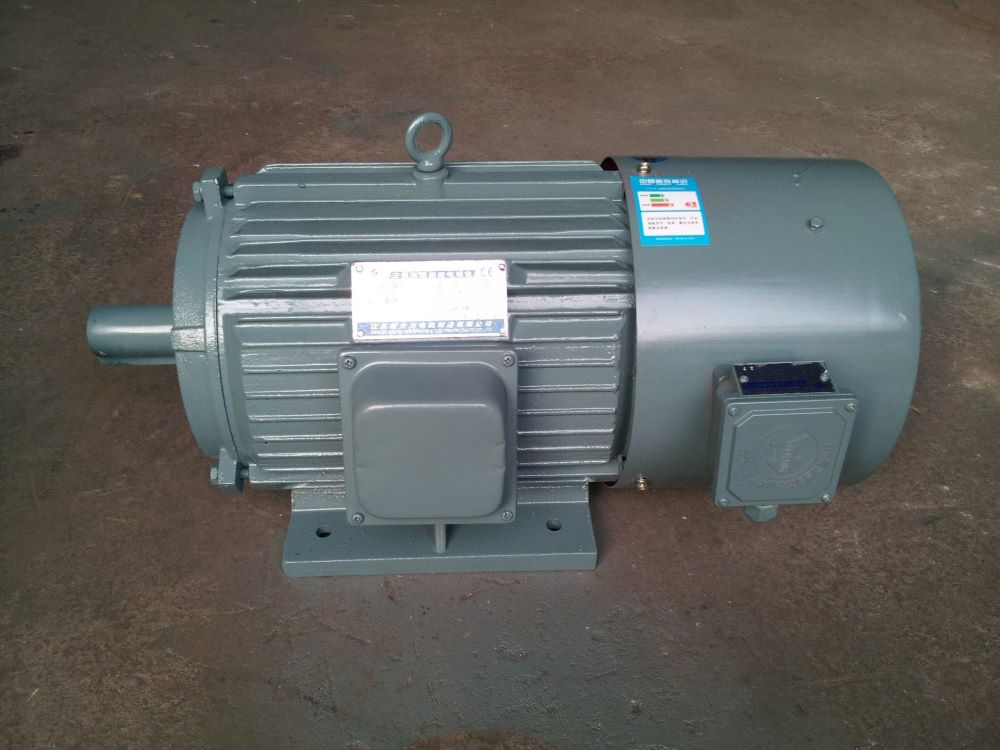가변 속도 모터는 어떻게 작동합니까??
ㅏ 가변 속도 전기 모터 다양한 속도로 작동할 수 있는 전기모터이다., 기존 전기모터처럼 고정된 속도가 아닌. 가변 속도 전기 모터에는 여러 유형이 있습니다., AC 유도 모터 포함, DC 모터, 브러시리스 DC 모터, 동기 모터. 가변 속도 전기 모터가 작동하는 구체적인 방법은 모터 유형에 따라 다릅니다..

AC 유도 전동기: 가변 속도 모터는 어떻게 작동합니까??
AC 유도 모터는 가장 일반적인 유형의 가변 속도입니다. 전기 모터 그리고 다양한 용도로 사용됩니다. 교류를 이용해 작동하는데 (교류) 모터를 구동하는 회전 자기장을 생성합니다.. AC 유도 모터의 속도는 모터에 적용되는 AC 전압의 주파수를 변경하여 제어할 수 있습니다..
AC 유도 전동기는 고정자로 구성됩니다. (모터의 고정 부분) 그리고 로터 (모터의 회전 부분). 고정자는 일반적으로 코어 주위에 감겨진 일련의 와이어 코일로 구성됩니다., 로터는 일반적으로 일련의 영구 자석으로 구성됩니다..
고정자에 AC 전압을 가할 때, 회전하는 자기장을 생성합니다.. 이 자기장은 회전자의 자기장과 상호 작용합니다., 고정자의 자기장에 맞춰 회전자가 회전하게 만드는 현상. 회전자의 속도는 고정자에 가해지는 AC 전압의 주파수에 정비례합니다..
고정자에 인가되는 AC 전압의 주파수를 변경함으로써, 로터의 속도를 제어할 수 있습니다.. 이는 일반적으로 가변 주파수 드라이브를 사용하여 수행됩니다. (VFD), 모터에 인가되는 교류전압의 주파수를 조정하는 장치입니다.. VFD는 일반적으로 AC 유도 모터의 속도를 제어하는 데 사용됩니다..
DC 모터: 가변 속도 모터는 어떻게 작동합니까??
DC 모터 직류를 사용하다 (DC) 회전 자기장을 생성하기 위해, 그리고 속도 모터를 제어할 수 있다 모터에 인가되는 전압을 조정하여. DC 모터는 일반적으로 정밀한 속도 제어가 필요한 응용 분야에 사용됩니다., 전기자동차나 로봇공학과 같은.
DC 모터는 고정자로 구성됩니다. (모터의 고정 부분) 그리고 로터 (모터의 회전 부분). 고정자는 일반적으로 코어 주위에 감겨진 일련의 와이어 코일로 구성됩니다., 로터는 일반적으로 일련의 영구 자석으로 구성됩니다..
고정자에 DC 전압을 가할 때, 회전하는 자기장을 생성합니다.. 이 자기장은 회전자의 자기장과 상호 작용합니다., 고정자의 자기장에 맞춰 회전자가 회전하게 만드는 현상. 회전자의 속도는 고정자에 가해지는 전압에 정비례합니다..
고정자에 인가되는 전압을 변경함으로써, 로터의 속도를 제어할 수 있습니다.. 이는 일반적으로 DC 드라이브를 사용하여 수행됩니다., 모터에 인가되는 전압을 조절하는 장치입니다.. DC 드라이브는 일반적으로 DC 모터의 속도를 제어하는 데 사용됩니다..
브러시리스 DC 모터: 가변 속도 모터는 어떻게 작동합니까??
가변 속도 브러시리스 DC 모터 (BLDC) 직류를 사용하는 전기모터의 일종이다. (DC) 회전 운동을 발생시키는 전원 공급 장치. 전통적인 것과 달리 브러시드 DC 모터, 기계식 브러시를 사용하여 전류를 회 전자에 전달하는 것, 브러시리스 DC 모터는 전자 정류를 사용하여 회전자에 대한 전류 흐름을 제어합니다.. 이는 보다 효율적이고 안정적인 모터를 가능하게 합니다., 마모되거나 전기 아크를 일으킬 수 있는 기계식 브러시가 없기 때문입니다..
브러시리스 DC 모터의 속도를 제어하려면, 가변 주파수 드라이브 (VFD) 일반적으로 사용됩니다. VFD는 모터에 공급되는 전력의 주파수를 변경하여 전기 모터의 속도를 제어하는 전자 장치입니다.. 전력의 주파수를 변경함으로써, VFD는 모터 회전자가 초당 회전하는 횟수를 변경하여 모터 속도를 제어할 수 있습니다..
VFD를 사용하여 브러시리스 DC 모터의 속도를 제어하려면, VFD는 먼저 들어오는 교류 전류를 변환합니다. (교류) 직류로 전력을 공급하다 (DC) 정류기를 이용한 전력. 그런 다음 DC 전원이 인버터로 공급됩니다., 이를 다른 주파수의 AC 전원으로 다시 변환합니다.. 그런 다음 AC 전원이 모터에 공급됩니다., 전력의 주파수에 따라 결정된 속도로 회전하게 만듭니다..
모터의 속도를 제어하는 것 외에도, VFD는 모터 회전 방향을 제어하는 역할도 담당합니다.. 모터에 공급되는 전력의 극성을 반대로 함으로써, VFD로 인해 모터가 반대 방향으로 회전할 수 있습니다..
전반적인, 가변 속도 브러시리스 DC 모터는 광범위한 응용 분야에 중요한 도구입니다., HVAC 시스템을 포함한, 슬리퍼, 팬, 그리고 컨베이어 벨트. 모터의 속도를 정밀하게 제어함으로써, 가변 속도 브러시리스 DC 모터는 효율성 향상에 도움이 될 수 있습니다., 에너지 소비 감소, 시스템의 전반적인 성능을 향상시킵니다..

동기 모터: 가변 속도 모터는 어떻게 작동합니까??
가변 속도 동기 모터는 특정 동기 속도에서 작동하는 전기 모터 유형입니다., 이는 모터에 공급되는 전력의 주파수와 모터의 극수에 의해 결정됩니다.. 동기 모터의 속도는 모터에 공급되는 전력의 주파수를 변경하여 변경할 수 있습니다., 가변 주파수 드라이브를 사용하거나 (VFD) 또는 모터의 극 수를 변경하여.
동기 모터의 속도를 제어하는 한 가지 방법은 가변 주파수 드라이브를 사용하는 것입니다. (VFD). VFD는 모터에 공급되는 전력의 주파수를 변경하여 전기 모터의 속도를 제어하는 전자 장치입니다.. 전력의 주파수를 변경함으로써, 그만큼 VFD 모터의 회전자가 초당 회전하는 횟수를 변경하여 모터의 속도를 제어할 수 있습니다..
VFD를 사용하여 모터 속도를 제어하려면, VFD는 먼저 들어오는 교류 전류를 변환합니다. (교류) 직류로 전력을 공급하다 (DC) 정류기를 이용한 전력. 그런 다음 DC 전원이 인버터로 공급됩니다., 이를 다른 주파수의 AC 전원으로 다시 변환합니다.. 그런 다음 AC 전원이 모터에 공급됩니다., 전력의 주파수에 따라 결정된 속도로 회전하게 만듭니다..
동기 모터의 속도를 제어하는 또 다른 방법은 모터의 극 수를 변경하는 것입니다.. 모터의 극 수는 모터 고정자 주변의 자기장 쌍 수를 나타냅니다.. 극의 개수가 많을수록, 모터가 주어진 주파수에서 더 느리게 회전합니다. 모터의 극 수를 변경하여, 모터가 회전하는 속도를 제어할 수 있습니다..
전반적인, 가변 속도 동기 모터는 다음 용도로 유용합니다. 정밀한 제어가 가능한 애플리케이션 모터 속도 이상이 필요합니다., HVAC 시스템과 같은, 슬리퍼, 팬, 그리고 컨베이어 벨트. 모터의 속도를 정밀하게 제어함으로써, 가변 속도 동기 모터는 효율성 향상에 도움이 될 수 있습니다., 에너지 소비 감소, 시스템의 전반적인 성능을 향상시킵니다..



